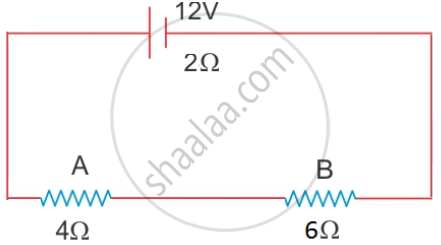Advertisements
Advertisements
Question
Three resistors are connected to a 6 V battery as shown in the figure given below:

Calculate:
(i) the equivalent resistance of the circuit.
(ii) total current in the circuit.
(iii) potential difference across the 7.2 Ω resistor.
Solution
(i) `1/"R"_1 = 1/8 + 1/12`
`= (3 + 2)/24 = 5/24`
R1 = 4.8 ohm.
Total Resistance = 4.8 + 7.2 = 12 ohm
(ii) V = IR
6 = I × 12
I = 0.5 Amp.
(iii) V = IR
= 0.5 × 7.2
= 3.6 Volt.
APPEARS IN
RELATED QUESTIONS
A battery of emf 12 V and internal resistance 2 Ω is connected with two resistors A and B of resistance 4 Ω and 6 Ω respectively joined in series.

Find:
1) Current in the circuit
2) The terminal voltage of the cell
3) The potential difference across 6Ω Resistor
4) Electrical energy spent per minute in the 4Ω resistor.
You have three resistors of values 2Ω, 3Ω and 5Ω. How will you join them so that the total resistance is more than 7Ω?
1) Draw a diagram for the arrangement
2) Calculate the equivalent resistance.
Which of the following statements correctly defines a volt?
(a) a volt is a joule per ampere.
(b) a volt is a joule per coulomb.
Which device is used to measure p.d?
What is the SI unit of potential difference?
How is a voltmeter connected in the circuit to measure the potential difference between two points? Explain with the help of a diagram.
The device used for measuring potential difference is known as:
If the potential difference between the end of a wire of fixed resistance is doubled, by how much does the electric power increase?
Calculate the current flowing through each of the resistors A and B in the circuit shown in the following figure.

A boy records that 4000 joules of work are required to transfer 10 coulombs of charge between two points of a resistor of 50 Ω. The current passing through it is:
